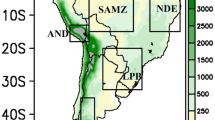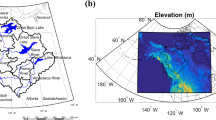Abstract
This study examines the projections of hydroclimatic regimes and extremes over Andean basins in central Chile (∼ 30–40° S) under a low and high emission scenarios (RCP2.6 and RCP8.5, respectively). A gridded daily precipitation and temperature dataset based on observations is used to drive and validate the VIC macro-scale hydrological model in the region of interest. Historical and future simulations from 19 climate models participating in CMIP5 have been adjusted with the observational dataset and then used to make hydrological projections. By the end of the century, there is a large difference between the scenarios, with projected warming of ∼ + 1.2 °C (RCP2.6), ∼ + 3.5 °C (RCP8.5) and drying of ∼ − 3% (RCP2.6), ∼ − 30% (RCP8.5). Following the strong drying and warming projected in this region under the RCP8.5 scenario, the VIC model simulates decreases in annual runoff of about 40% by the end of the century. Such strong regional effect of climate change may have large implications for the water resources of this region. Even under the low emission scenario, the Andes snowpack is projected to decrease by 35–45% by mid-century. In more snowmelt-dominated areas, the projected hydrological changes under RCP8.5 go together with more loss in the snowpack (75–85%) and a temporal shift in the center timing of runoff to earlier dates (up to 5 weeks by the end of the century). The severity and frequency of extreme hydroclimatic events are also projected to increase in the future. The occurrence of extended droughts, such as the recently experienced mega-drought (2010–2015), increases from one to up to five events per 100 years under RCP8.5. Concurrently, probability density function of 3-day peak runoff indicates an increase in the frequency of flood events. The estimated return periods of 3-day peak runoff events depict more drastic changes and increase in the flood risk as higher recurrence intervals are considered by mid-century under RCP2.6 and RCP8.5, and by the end of the century under RCP8.5.





Similar content being viewed by others
References
Adam JC, Hamlet AF, Lettenmaier DP (2009) Implications of global climate change for snowmelt hydrology in the twenty-first century. Hydrol Process 23(7):962–972. https://doi.org/10.1002/hyp.7201
Boisier JP, Rondanelli R, Garreaud R, Muñoz F (2016) Anthropogenic and natural contributions to the Southeast Pacific precipitation decline and recent megadrought in central Chile. Geophys Res Lett 43(1):413–421. https://doi.org/10.1002/2015GL067265
Bozkurt D, Sen OL, Hagemann S (2015) Projected river discharge in the Euphrates-Tigris Basin from a hydrological discharge model forced with RCM and GCM outputs. Climate Res 62:131–147. https://doi.org/10.3354/cr01268
Cortés G, Vargas X, McPhee J (2011) Climatic sensitivity of streamflow timing in the extratropical western Andes Cordillera. J Hydrol 405:93–109. https://doi.org/10.1016/j.jhydrol.2011.05.013
CR2 (2015) The 2010-2015 mega-drought: a lesson for the future: report to the nation. Center for Climate and Resilience Research, University of Chile, Santiago, Chile. http://www.cr2.cl/megasequia
Demaria EMC, Maurer EP, Sheffield J, Bustos E, Poblete D, Vicuñna S, Meza F (2013a) Using a gridded global dataset to characterize regional hydroclimate in central Chile. JHydrometeor 14(1):251–265. https://doi.org/10.1175/JHM-D-12-047.1
Demaria EMC, Maurer EP, Thrasner B, Vicuñna S, Meza F (2013b) Climate change impacts on an alpine watershed in Chile: do new model projections change the story? J Hydrol 502:128–138. https://doi.org/10.1016/j.jhydrol.2013.08.027
Falvey M, Garreaud R (2007) Wintertime precipitation episodes in Central Chile: associated meteorological conditions and orographic influences. J Hydrometeor 8:171–193
Falvey M, Garreaud R (2009) Regional cooling in a warming world: recent temperature trends in the southeast Pacific and along the west coast of subtropical South America (1979-2006). J Geophys Res 114(D04):102
Garreaud R, Garreton CA, Barichivich J, Boisier JP, Christie D, Galleguillos M, LeQuesne C, McPhee J, Bigiarini MZ (2017) The 2010-2015 mega drought in Central Chile: impacts on regional hydroclimate and vegetation. Hydrol Earth Syst Sci Discuss. https://doi.org/10.5194/hess-2017-191
Gilleland E, Katz RW (2015) extremes 2.0: an extreme value analysis package in r. Journal of Statistical Software Forthcoming
Giorgi F, Lionello P (2008) Climate change projections for the Mediterranean region. Glob Planet Chan 63(2-3):90–104. https://doi.org/10.1016/j.gloplacha.2007.09.005
Hagemann S, Chen C, Clark DB, Folwell S, Gosling SN, Haddeland I, Hanasaki N, Heinke J, Ludwig F, Voss F, Wiltshire AJ (2013) Climate change impact on available water resources obtained using multiple global climate and hydrology models. Earth Syst Dynam 4:129–144. https://doi.org/10.5194/esd-4-129-2013
Hall DK, Riggs GA, Salomonson VV (2006) Modis/terra snow cover monthly l3 global 0.05deg cmg v005
Hannah L, Roehrdanz PR, Ikegami M, Shepard AV, Shaw MR, Tabor G, Zhi L, Marquet PA, Hijmans RJ (2013) Climate change, wine, and conservation. Proc Natl Acad Sci(USA) 110(17):6907–6912. https://doi.org/10.1073/pnas.1210127110
Hansen JW, Challinor A, Ines A, Wheeler T, Moronet V (2006) Translating forecasts into agricultural terms: Advances and challenges. Climate Res 33:27–41. https://doi.org/10.3354/cr033027
Immerzeel WW, van Beek LPH, Bierkens MFP (2010) Climate change will affect the Asian water towers. Science 328:1382–1385
IPCC (2014) Climate Change (2014). In: Pachauri RK, Meyer LA (eds) Synthesis Report. Contribution of Working Groups I, II and III to the Fifth Assessment Report of the Intergovernmental Panel on Climate Change. Core Writing Team. IPCC, Switzerland
Lehner B, Verding K, Jarvis A (2008) New global hydrography derived from spaceborne elevation data. Eos Trans AGU 89:93–94
Liang X, Lettenmaier DP, Wood E, Burges SJ (1994) A simple hydrologically based model of land surface water and energy fluxes for general circulation models. J Geophys Res 99(D7):14,415–14,428. https://doi.org/10.1029/94JD00483
Martens B, Miralles DG, Lievens H, van der Schalie R, de Jeu RAM, Fernandez-Prieto D, Beck HE, Dorigo WA, Verhoest NEC (2016) Gleam v3: satellite-based land evaporation and root-zone soil moisture. Geosci Model Dev Discuss. https://doi.org/10.5194/gmd-2016-162
Masiokas MH, Villalba R, Luckman BH, Quesne L, C A CJ (2006) Snowpack variations in the Central Andes of Argentina and Chile, 1951-2005: large-scale atmospheric influences and implications for water resources in the region. J Climate 19:6334–6352
Mendoza PA, Clark MP, Mizukami N, Newman AJ, Barlage M, Gutmann ED, Rasmussen RM, Rajagopalan B, Brekke LD, Arnold JR (2015) Effects of hydrologic model choice and calibration on the portrayal of climate change impacts. J Hydrometeor 16:762–780
Ohmura A, Wild M (2002) Is the hydrological cycle accelerating? Science 298:1345–1346
Onol B, Bozkurt D, Turuncoglu UU, Sen OL, Dalfes HN (2014) Evaluation of the 21st century RCM simulations driven by multiple GCMs over the Eastern Mediterranean-Black Sea region. Climate Dyn 42:1949–1965. https://doi.org/10.1007/s00382-013-1966-7
Piani C, Weedon GP, Best M, Gomes S, Viterbo P, Hagemann S, Haerter JO (2010) Statistical bias correction of global simulated daily precipitation and temperature for the application of hydrological models. J Hydrol 395:199–215. https://doi.org/10.1016/j.jhydrol.2010.10.024
Ruttlant J, Fuenzalida H (1991) Synoptic aspects of the central Chile rainfall variability associated with the Southern Oscillation. Int J Climatol 11:63–76
Stewart IT, Cayan DR, Dettinger MD (2005) Changes toward earlier streamflow timing across western north america. J Climate 18:1136–1155
Taylor KE, Stouffer RJ, Meehl GA (2012) An overview of CMIP5 and the experiment design. Bull Amer Meteor Soc 93:485–498
Vicuña S, Garreaud R, McPhee J (2011) Climate change impacts on the hydrology of a snowmelt driven basin in semiarid Chile. Clim Change 105:469–488. https://doi.org/10.1007/s10584-010-9888-4
Acknowledgements
We acknowledge the World Climate Research Programme Working Group on Coupled Modelling, which is responsible for CMIP, and we thank the climate modeling groups (listed in Table S1 in the supplementary materials) for producing and making available their model output. For CMIP, the U.S. Department of Energy Program for Climate Model Diagnosis and Intercomparison provides coordinating support and led development of software infrastructure in partnership with the Global Organization for Earth System Science Portals. DB acknowledges support from FONDECYT grant 3150036. MR acknowledges support from NC120066 and FONDECYT grant 1171773. JPB acknowledges support from FONDECYT grant 3150492. In particular, we are thankful to Justin Sheffield (Princeton University) and Edwin P. Maurer (Santa Clara University) for providing the VIC model parameter files and gridded meteorological fields.
Funding
This work was funded by FONDAP-CONICYT 15110009.
Author information
Authors and Affiliations
Corresponding author
Additional information
This paper is a substantially revised version of Climate change impacts on hydroclimatic regimes and extremes over Andean basins in central Chile https://doi.org/10.5194/hess-2016-690
Electronic supplementary material
Below is the link to the electronic supplementary material.
Rights and permissions
About this article
Cite this article
Bozkurt, D., Rojas, M., Boisier, J.P. et al. Projected hydroclimate changes over Andean basins in central Chile from downscaled CMIP5 models under the low and high emission scenarios. Climatic Change 150, 131–147 (2018). https://doi.org/10.1007/s10584-018-2246-7
Received:
Accepted:
Published:
Issue Date:
DOI: https://doi.org/10.1007/s10584-018-2246-7




